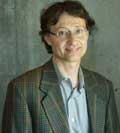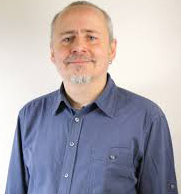
The 6th Global Conference on Materials Science and Engineering
October 24th - 27th, 2017, Beijing, China

 |
Prof. Harry E. Ruda Department of Materials Science & Engineering, University of Toronto, Canada Speech Title: Prospects for Nanowire Optoelectronics |
| Abstract: This paper concerns the prospects and limitations for nanowire (NW) optoelectronics. Firstly, we discuss the nature of confinement of carriers in NWs, the role of surfaces and bulk defects, as reflected in the anisotropic optical response and from single NW steady state and time resolved PL. Next we discuss the role of surface state occupation on carrier transport using measurements of random telegraph noise and THz conductivity, and conclude with the implications for NW based optoelectronic devices – this includes devices such as single NW photodetectors with high gain, and ultra-sensitive electrometers. | |
 |
Dr. Alexander Khotsianovsky Pisarenko Institute of Problems of Strength of the National Academy of Sciences of Ukraine, Ukraine Speech Title: Engineering Forecasts of High-Speed Underwater Motion: Supercavitation, Polymer Injection, and Electromagnetic Breakthrough Solutions |
|
Abstract: The in-water motion speed of modern underwater vehicles and projectiles is limited by viscous resistance (drag) of water, which grows exponentially with the motion speed. In this respect, even the latest 7 Mach projectile (electromagnetic railgun), which moves seven times the speed of sound in air, is unable to go through the depth of waters of several hundred meters, unless special drag-reducing technologies are applied. The presentation covers the state-of-the-art developments worldwide in drastic drag reduction, which can be classified as i) artificial supercavity formation behind a cavitator, ii) injection of aqueous polymer solutions, and iii) electromagnetic effect induced by Lorentz forces. The first approach was successfully implemented in civil (SWATH) and particular military applications, e.g., Shkval (USSR, 1977) and Barracuda (Germany, 2005) high-speed torpedoes. Its operating principle includes the underwater vehicle hull separation from water using a disk- or cone-shaped cavitator, which "opens an umbrella" over the major part of the hull to produce an ellipsoidal air bubble (supercavity) inflated by an artificial or natural air inflow, providing a very high motion speed. The second one, related to the addition of low-concentration polymer solutions into turbulent shear flows, was introduced in 1948 by Toms (who coined the Toms effect of drag reduction by up to 80%), attained its peak of development in mid-70s due to works of Virk, Tulin, and others, but was dwindling in the last three decades, until a breakthrough solution was reported in 2015 by Chinese scientists. It implies the evolution of the cavitation flow by supplying the aqueous solutions of high-molecular linear-chain polymers, which form a "liquid membrane" around an underwater vehicle and ensure its stable in-water ultrasonic motion. In this outlook, the above achievements are compared to those of the post-Soviet school of Shkval developers (Ukraine and Russia) and HSUV (US). The third aspect comes into light as news-breaking reports on the satisfactory launch of electromagnetic railgun projectiles by the US Navy in 2017. This principle takes the advantage of the well-known Lorentz force, which acts in the perpendicular direction to the plane encompassing the magnetic and electric currents. The underwater motion of these projectiles became the hotspot of recent research, including the ONR Project (US). In this respect, an expected 30% drag reduction and specific flow separation due to the electromagnetic effect can be combined with a conic cavitator and a single or continuous injection of polymer solutions after the moment of water entry, thus providing a quite effective water-penetrating projectile or first-stage carrier for a small-scale underwater vehicle of good maneuverability. The advantages and limitations of the above approaches and their potentials are summarized. | |
 |
Prof. Sigitas Tamulevičius Member of the European Materials Research Society Professor of the Physics Department, Kaunas University of Technology (KTU), Republic of Lithuania Speech Title: Plasmonic properties of nanoparticles and nanocomposites |
|
Abstract: Plasmonic properties and the ultrafast processes taking place in noble metal nanostructures is a hot topic of the recent decades because it leads to vast range of interdisciplinary applications. Noble metal nanoparticle analysis is important in many interdisciplinary areas ranging from electrooptics, sensing to biomedical application. One of the intensively explored field in ultrafast plasmonics is lattice dynamics of different nanostructures that takes place in picosecond time scales. Acoustical phonon excitation has been observed in different kinds of plasmonic metal nanostructures, including gold nanoparticles, nanorings and nanowires as well as silver nanocubes and even bimetallic core shell structures. Transient absorption spectroscopy traces of such nanostructures demonstrate rapid picosecond decay of the signal followed by clear modulations due to coherently excited vibrational modes. A short picosecond time scale transient signal is due to the ultrafast heating of the electron gas, followed by fast thermalization with the lattice vibrations, while on a longer time scale, clear periodic oscillations are visible together with a slowly varying background that can be ascribed to the thermalization of the nano-object with its environment. In this work we investigated cubic Ag nanoparticles prepared by wet chemistry of different edge lengths ranging from 39 nm to 104 nm. Ultra-monodispersed colloidal nanoparticles were coated with TiO2. Analyzing the nanocube samples by means of transient absorption spectroscopy we studied the coherent oscillations of Ag nanocubes and nanocube core shell structures. The results suggest that oscillation period (40-100 ps), damping time (30-160 ps), phase and Q factor (6-22) are determined by the nanocube edge length. The presence of TiO2 shell of different thickness has minor influence on the oscillation period but decreases the Q factor. We found that adding of TiO2 layer on Ag nanocubes did not change the structure of cubic Ag nanoparticles showing the selected method promising for synthesis of plasmonic heterostructures. Thermal expansion analysis was used to examine the continuum dynamics of the nanocubes in the frequency domain using finite element methods. Additionally, regular assemblies of nanocubes were deposited in hexagonal arrays on PDMS templates by employing capillary assisted particle deposition. Dark field optical microscopy demonstrated that number of particles per single trapping site has a big influence on the resonant wavelength and intensity of the scattered light. In addition to the plasmonic effects in monodispersed particles we have conducted research of diamond like carbon based nanocomposites including metallic (Cu, Ag) nanoparticles, where we have demonstrated possible applications of the effect in photovoltaic cells. | |
 |
Dr. William M. Cox Director and Principal Consultant, Corrosion Management Limited, UK Speech Title: Forensic Coating Inspection-What is it and Why does it Differ from Conventional Coating Inspection? |
|
Abstract: Rigorous adherence to specified clauses covering surface preparation requirements, environmental conditions and methods of coating application along with coating manufacturers recommended procedures are imperative if the predicted integrity and service life of modern high-performance coating systems are to be realised. However, conventional coating inspection procedures are not intended, or necessarily are suitable, to characterize the condition of existing coatings that need either to be removed, refurbished, or left to deteriorate naturally, or to determine the optimum timing for coating maintenance interventions. This paper outlines the principles of both routine inspection and forensic coating examination, then describes the different procedures that are applied to investigate in-situ coatings to identify aspects such as substrate contamination, toxic contaminants, degree of cure, degradation, inter-coating disbondment, suitability and/or compatibility for overcoating, removal or disposal and what these specific examinations reveal and how they are likely to impact coating removal and/or maintenance activities. Examples are included to illustrate the findings from such an examination should be used to formulate the basis of a reliable long-term corrosion protection scheme for strategic assets such as bridges, storage tanks flood barriers, etc. | |
 |
Prof. Willi Pabst Department of Glass and Ceramics, University of Chemistry and Technology, Prague (UCT Prague), Czech Republic Speech Title: Temperature Dependence of Young’s Modulus and Damping of Oxide and Silicate Ceramics and Refractories |
| Abstract: The high-temperature mechanical behavior of ceramics and refractories is determined by both elastic and anelastic contributions. While the elastic properties determine the high-temperature stiffness and thermal shock resistance of these materials, damping reflects certain deviations from elastic behavior in the vibrational response of these materials that are indicative of dissipative processes. Both elastic properties and damping are principally dependent on the phase composition, microstructure (especially the content of pores and microcracks), and temperature. While the phase composition and microstructure determines the absolute values of the elastic properties and damping, the temperature dependence of these properties often reveals phase transitions and subtle microstructural features. This contribution summarizes results of high-temperature impulse excitation measurements for several important classes of oxide and silicate refractory ceramic materials (alumina- and zirconia-based ceramics, mullite-based ceramics, kaolin- and talc-based ceramics, and silica refractories). The results indicate that the temperature dependence of the Young’s modulus is not always monotonic and reversible, but may exhibit characteristic non-monotonic features due to phase transitions and hysteresis loops between heating and cooling (with or without damage accumulation) because of microcrack closure and re-opening. The temperature dependence of damping exhibits a comparable complexity. It is shown that the temperature dependence of Young’s modulus and damping is particularly interesting for silica refractories, that the presence of cristobalite is easily revealed from the temperature dependence of Young’s modulus and that the temperature dependence of damping can serve as a very sensitive probe providing additional information on phase transitions that may not be evident from the temperature dependence of elastic properties. | |
 |
Dr R S Beniwal Sr. Principal Scientist, CSIR-NISCAIR, INDIA Speech Title: Elastic Properties of Composite Materials |
| Abstract: This paper explains the elastic properties of composite materials and provides a brief description of the knowledge of composites and basic elastic properties needed for understanding the concept. The elastic constants and their applications in the field of science and technology have also been discussed. The parameters on which elastic constants are dependent have been analyzed in brief. Nowadays, the nanostructurization process is an effective way to modify the physical, chemical and mechanical properties of the materials. In this paper, the concept of microstructure and interconnectivity of phases at interface is used. The modified version of Hashin-Shtrikman relations for bulk and shear moduli is discussed. A comparison shows that predicted values of elastic properties using modified relations are quite close to the reported experimental results. | |